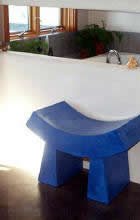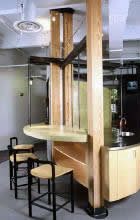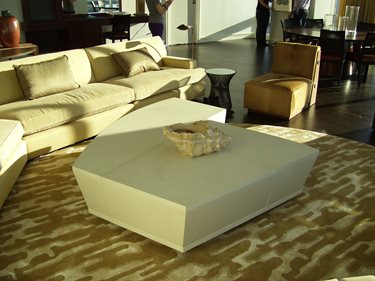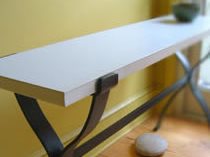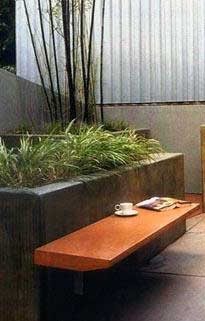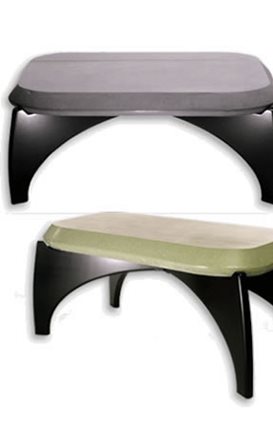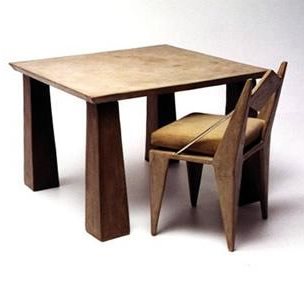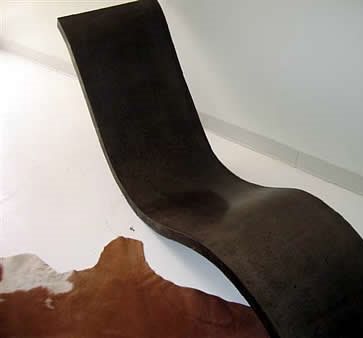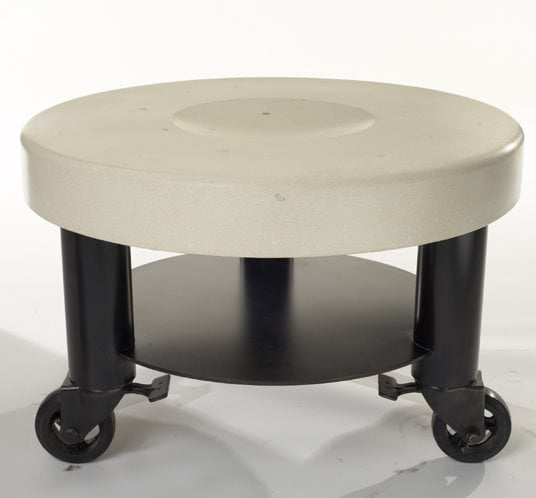- Concrete Furniture Home
- Concrete Furniture Photos
- Concrete Furniture Types
- Concrete Coffee Tables
- Outdoor Concrete Furniture
- Concrete Office Furniture
- Concrete Storage Furniture
- Concrete Ping Pong Tables
- Design Ideas
- Concrete Furniture Design Ideas: Behind-the-scenes info and photos
- Free Concrete Furniture Catalog
- Related Information
- Learn How to Make Bent Concrete Furniture
- Concrete Contractors: Find GFRC Mixes for Precast Concrete
CONCRETE FURNITURE 101
With its ability to be molded into any shape, concrete is ideal for creating furniture pieces with character and craftsmanshipMany of us think of concrete only as something we can walk on, drive on or build foundations with—not as a material we can lounge on, eat off of, use to display books and knickknacks, or fashion into furniture for a conference room or home office.
 Concrete Furniture Pictures
Browse our indoor concrete furniture photo gallery.
Concrete Furniture Pictures
Browse our indoor concrete furniture photo gallery.
 Concrete Storage Solutions
Get ideas for how to use concrete furniture to create more storage space.
Concrete Storage Solutions
Get ideas for how to use concrete furniture to create more storage space.
 Find Products: Concrete Molds
Guidance for buying or making formwork for concrete furniture and more.
Find Products: Concrete Molds
Guidance for buying or making formwork for concrete furniture and more.
 Concrete Style Guides
Download these design sheets for concrete furniture ideas in modern, old-world and traditional design schemes.
Concrete Style Guides
Download these design sheets for concrete furniture ideas in modern, old-world and traditional design schemes.
 Outdoor Concrete Furniture Pictures
Discover photos of concrete furniture for your patio and more.
Outdoor Concrete Furniture Pictures
Discover photos of concrete furniture for your patio and more.
 Concrete Fireplace Surrounds
See how fireplaces framed with decorative concrete offer unlimited opportunities for personalization.
Concrete Fireplace Surrounds
See how fireplaces framed with decorative concrete offer unlimited opportunities for personalization.
Greenbrae Concrete Chair Design
Time: 01:19
Welcome to the new age of decorative concrete—a time when you're as likely to encounter a concrete dining table, bench, bookcase, countertop or chair as you are a concrete patio. More furniture designers and artisans are abandoning wood and other traditional furniture materials and using concrete to build one-of-a-kind pieces that bring a unique sense of style to homes and businesses, indoors and out
For those of us new to or even skeptical about the concept of concrete furniture, here's a look at why it's becoming so popular, who's making it, some misconceptions about concrete furniture, and the endless ways you can use concrete to blend with or complement any décor.
Find a Concrete Furniture Contractor
WHY CONCRETE FURNITURE?
"Concrete is one of the oldest, strongest and most durable materials that humans have ever made. Because it is mixed and poured, its variations and design potentials are almost infinite Applications are limited only by the imagination," says Wanda Ellerbeck of Grotto Designs in Calgary, Alberta, Canada.
"Concrete is one of the oldest, strongest and most durable materials that humans have ever made. Because it is mixed and poured, its variations and design potentials are almost infinite Applications are limited only by the imagination," says Wanda Ellerbeck of Grotto Designs in Calgary, Alberta, Canada.
Concrete offers many qualities for furniture:
- It's versatile and can be molded to have soft, graceful curves and warm, soothing color tones.
- For a look that's bold and contemporary, fabricators can cast concrete into interesting geometric shapes and color it an array of bright, vivid hues.
- Because concrete can be poured to shape any form, it can also be cast to accommodate any existing space restrictions.
- Concrete offers a unique look and its creative possibilities are endless.
- Each concrete artisan approaches his or her craft personally, achieving a distinct look by building his or her own forms, developing special casting techniques, and using proprietary materials and coloring methods.
- Concrete also gives a natural look and feel and blends well with other design elements.
Fu-Tung Cheng of Cheng Designs says he was immediately drawn to the virtues of concrete. "It is easily sculpted, it takes any guise, and it mimics whatever you pour it into, I like to think of it as naturalistic. You can create your own topography and your own landscape."
Buddy Rhodes of Buddy Rhodes Studios says the design, color, and finish options are perhaps the most appealing aspects of concrete. That, plus the fact that it's hands-on and handcrafted.
Most concrete artisans are passionate about their work and take great pains to achieve superior results.
CONCRETE FURNITURE INDOORS
One of the greatest attributes of concrete is its ability to blend with or complement any style you're aiming to create. Its texture can range from smooth and polished-perfect for a refined look, to natural and coarse-charming in a rustic or Old World setting.
Many architectural concrete contractors create a range of furniture, including conference tables, bedsidetables, cocktail tables, accent tables, benches, beds, urban seating, kinetic tables and work stations.
Because of concrete's ability to mold into any shape, it can be created into virtually anything you have in mind.
"But while concrete can be used to create a modern or minimal look, it's also perfectly adaptable to a more traditional setting -- where it was so extensively used in the first place. In truth, there are no standard guidelines that, if followed, will guarantee you'll get a certain look. All "styles" are really just an amalgamation of details that evoke a certain feeling when used together."
"Extremeconcrete furnishings can complement any interior or architectural design platform from transitional, French country and eclectic to contemporary/modern, urban chic and extreme avant-garde."
Get more concrete furniture design ideas from these unique creations.
HOW TO TIPS & TRICKS FROM THE MASTERS
- Use a high performance, high strength mix for furniture fabrication, like GFRC
- Reusable fiberglass or urethane molds are good for creating the same piece multiple times
- Build your own custom forms using melamine or liquid rubber
- Grind the edge of a piece to expose the aggregate
- For a more rustic feel, try chipped edges
- Use concrete in conjunction with steel
COLOR CHOICES ABOUND FOR CONCRETE FURNITURE
"Concrete is the only material that allows you to customize just about every aspect of it, including color, shape, thickness, andtexture," says Jeff Girard of The Concrete Countertop Insitute in Raleigh, North Carolina.
One of the benefits of choosing concrete is the range of colors available. Each concrete contractor offers his or her own uniquestandard and premium colors. And many will create custom colors to help you match or complement other furniture.
Wanda Ellerbeck of Grotto Designs in Calgary, Alberta, Canada, says that back when she was starting out, the only colors available in Calgary were red, yellow, and black.
"I used a whole bunch of pigments to make my own, but they're nowhere close to the colors available today," she says.
Buy Concrete Products: Concrete Forms & Molds | GFRC Mixes
Today, Grotto Designs offers custom colors and stains, and integral pigments and applied stains can be used together for exotic and extraordinary effects.
Samples will always be different because each contractor has their own secret recipe and uses different types and amounts of cement and aggregates. In fact, cement will vary in different parts of the country. There are different brands of pigments, stains, and aggregate colors, so concrete furniture will always be one-of-a-kind.
At Meld USA in Raleigh, North Carolina, there are over 60 standard colors with more than 300 colors in the color library, which is continuously expanding.
Their in-house designed computer program develops batches, prints out the "recipe," catalogs colors, and provides the water-to-cement ratio.
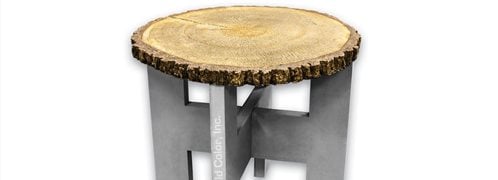 Urethane Furniture Molds
Log tables, benches and more
Urethane Furniture Molds
Log tables, benches and more
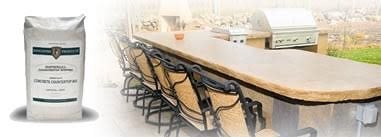 Imperial Mix
Lightweight, strong, minimal shrinkage
Imperial Mix
Lightweight, strong, minimal shrinkage
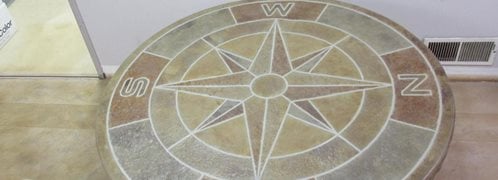 Table Top Molds
Live edge, compass, flags, checkboard, etc.
Table Top Molds
Live edge, compass, flags, checkboard, etc.
CONCRETE FURNITURE FACTS AND FICTION
Fiction: Concrete furniture is a recent innovation.
Fact: Thomas Edison-the inventor of the light bulb and one of the first to build cast-concrete houses (see Famous Concrete Homes)-came up with the idea of using concrete to make furniture back in 1911, claiming it would be more durable and affordable than wood and equally as attractive. To demonstrate, he made several pieces of furniture, including cabinets for his phonographs, using an air-impregnated foam concrete mixture he developed in his lab, which kept the weight down. Edison declared that his concrete pieces could be stained "to look like any type of wood desired." Although his novel idea didn't catch on at the time, he proved to be right about the potential of concrete as a furniture medium.
Fiction: All concrete furniture weighs a ton.
Fact: While it's true that a piece of furniture cast of traditional normal-weight concrete can be pretty darn heavy, the weight is often an advantage when it comes to outdoor pieces, keeping your furniture from turning into a projectile in high winds. For indoor furniture, many artisans use lightweight concrete mixes (an idea borrowed from Edison) to reduce the weight. They may also use fiber reinforcement so the elements can be made thinner without sacrificing strength. Large furniture pieces, such as bookshelves and conference tables, are often cast in smaller components for easier assembly and transport. Some furniture makers improve the mobility of heavier concrete pieces by mounting them on casters or rollers.
Fiction: Concrete seating is uncomfortable.
Fact: No more so than seating made of wrought iron or solid wood (think church pew). Cushions or pillows will significantly boost the comfort factor. Even without cushions, concrete seating can be comfortable. Some designers mold contours into their pieces to cradle you ergonomically.
Fiction: Concrete furniture will clash with the rest of my décor.
Fact: This is the biggest myth of all. With concrete's ability to be molded into any shape and assume any texture or color, it can blend beautifully with styles ranging from traditional to ultra-modern.
Thanks to the following concrete artisans who shared their expertise and insights for this article:
- Buddy Rhodes of Buddy Rhodes Studio was a former ceramist.
- Wanda Ellerbeck of Grotto Designs in Calgary, Alberta, Canada, is a renowned sculptor and Master of Fine Arts.
- Michael Bustin of Meld USA has degrees in physics and engineering and has also spent six years as a senior project manager for a commercial construction company.
- DEX Studios consists of talented artists and designers that share a common goal and passion.
- Elemental Surfaces Rick Parks and Lilian Myers share a background in the technology and construction industries.
